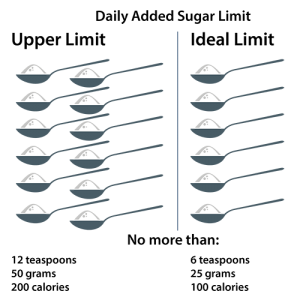Sugar. Is all this sweetness a problem?
This post is also available in:
 French
French
By Maribeth Evezich, MS, RD
If you’re not monitoring your intake, sugar could be sabotaging your health and weight. Because when it comes to sugar, ignorance is not bliss. Here’s why.

Not long ago, added sugars were only a concern due to being “empty calories” promoting obesity and dental cavities. While considered an “unhealthy indulgence,” sugar’s only known risks were to our teeth and waistline and perhaps inadequate nutrition. But then the research started piling up.
Today we know better. Added sugar overconsumption is recognized as an independent risk factor in cardiovascular disease as well as many other chronic diseases, including diabetes mellitus, liver cirrhosis, and dementia—and is linked to dyslipidemia, hypertension, and insulin resistance.1 So the concern over added sugar overconsumption has broadened to our whole body with potential health issues from head to toe, literally. In fact, according to UCSF School of Medicine professor Laura A. Schmidt’s invited commentary in JAMA Internal Medicine, “Too much sugar does not just make us fat; it can also make us sick.” Further, excess sugars are associated with premature aging as their by-products build up in connective tissue, promoting stiffness and loss of elasticity.2,3 Think wrinkles.
How much is too much?

Not surprisingly, many of the major health institutions recommend limiting added sugars. The World Health Organization (WHO) specifically recommends adults and children reduce their daily intake of added sugars to less than 10% of their total energy intake and, ideally, 5% or roughly 25 grams per day for additional health benefits for most people.4
How are Canadians doing?
Well (compared to your neighbors to the South)—but could be better. According to Canadian Community Health Survey data, Canadians average 51 grams of added sugar per day.5 That’s more than twice the WHO’s recommendation, translating to an extra 26 grams and 104 calories per day.
Concerned about your weight? Do the math. That’s about a pound worth of calories (3,500) every 34 days. So an average Canadian staying within the WHO guidelines would theoretically be 10 pounds lighter in a year.
Where is all this added sugar coming from?
Most added sugar comes from processed and prepared foods. Beverages (soft drinks, fruit drinks, sweetened coffee and tea, energy drinks, alcoholic beverages, and flavored waters) are the biggest culprit. For example, with as many as 11 teaspoons (46.2 grams) of added sugar in one 12-oz. soda, a single serving is close to double the recommended limit for many people. The other major sugar bombs are snacks and sweets (grain-based desserts, dairy desserts, puddings, candies, sugars, jams, syrups, and sweet toppings).6
Further, sugar is pervasive in our food supply. You’ll find it lurking in some not-so-obvious places, including savory foods, such as bread and pasta sauce, fruit juices, and bottle sauces, dressings, and condiments, such as ketchup. In fact, you’ll find added sugar in 74% of packaged foods sold in many North American supermarkets, including those marketed as “healthy,” “natural,” “low-fat,” or “gluten-free.”7 They’re everywhere. The only way to keep them at a minimum is to eat whole, minimally processed foods.
In the next post in this series, we’ll look at why sugar cravings are so tough to conquer and the help you identify hidden sugars in your diet.
REFERENCES
- Schmidt LA. New unsweetened truths about sugar. JAMA Intern Med. 2014;174(4):525–526.
- Lee EJ et al. Advanced glycation end products (AGEs) promote melanogenesis through receptor for AGEs. Sci Rep. 2016;6:27848.
- Today’s Dietitian. http://www.todaysdietitian.com/newarchives/030314p10.shtml. Accessed November 28, 2017.
- Vos MB et al. Added sugars and cardiovascular disease risk in children: a scientific statement from the American Heart Association. Circulation. 2016;135(19):e1017-e1034.
- World Health Organization. Sugars intake for adults and children, Guideline. http://www.who.int/nutrition/publications/guidelines/sugars_intake/en/. Accessed April 18, 2018.
- U.S. Department of Health and Human Services and U.S. Department of Agriculture. 2015 – 2020 Dietary Guidelines for Americans. 8th Edition. December 2015.
- Ng SW et al. Use of caloric and noncaloric sweeteners in US consumer packaged foods, 2005-2009. J Acad Nutr Diet. 2012;112(11):1828-1834.






